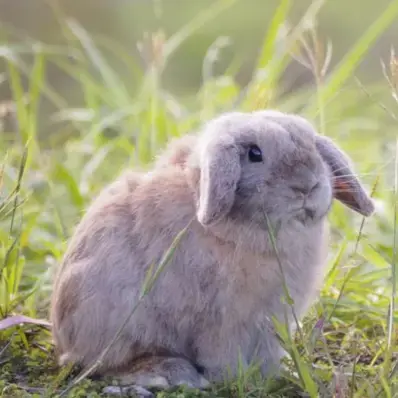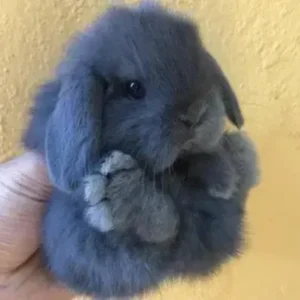History/Origin
Originated in the Netherlands, the Holland Lop rabbit appeared in the 1950s. Renowned rabbit breeder Adriann de Cock aimed to create a small-sized rabbit breed with a friendly disposition and distinctive lopped ears. To achieve this, he carefully crossed French Lop and Netherland Dwarf rabbits, resulting in the creation of the Holland Lop.
It was recognized by the American Rabbit Breeders Association (ARBA) in 1979 and has since become the most widely known domestic rabbit breed.
Personality
Known for their gentle nature, Holland Lops make wonderful family pets. They are social, enjoy human interaction, and are often described as laid-back and easygoing. However, they could often be shy, trying to avoid interaction. Their docile temperament makes them suitable for households with children and other pets, and they are easy to train.
That doesn’t mean they’re lazy – they actively display their rabbit needs, such as playtime and exercise. They could also be sometimes a bit mischievous and destructive, but that’s rare for these Loppy friends.
Physical Appearance
The distinctive feature of the Holland Lop is their lopped ears, which droop down to the sides of their faces, adding to their cuteness.
- Size
Holland Lops are small-sized rabbits weighing between 2 and 4 pounds, with a compact and sturdy build. They can be up to 10-12 inches long when stretched and grow up to 4 to 5 inches in height.
- Coat Color
These rabbits come in various colors and patterns, including agouti, self, shaded, broken, and more. The variety in coat colors adds to the charm of the breed.
Gender Differences
Both male and female Holland Lops become great pets. However, they have a few differences in characteristics that you should know to take better care of them.
- Appearance
Male Holland Lops typically exhibit a slightly larger physique compared to females. The size difference is generally subtle but noticeable when closely observed. Otherwise, there’s very little obvious difference between male and female holland lops.
- Temperament
Male Holland Lops are often characterized by a more independent demeanor. While still affectionate with their owners, they might not be as overtly clingy as their female counterparts.
Meanwhile, female Holland Lops tend to be more social and affectionate. However, these differences in temperament are minute and differ from rabbit to rabbit. A Holland Lop’s gestation period is about 13-33 days, during which a female rabbit (called a doe) may require some more space for the nest.
Feed/Nutrition
Providing a well-balanced and nutritious diet is crucial for the overall health and well-being of your Holland Lop rabbit.
- Hay
The cornerstone of a Holland Lop’s diet is high-quality hay. Hay is essential for dental health, digestion, and overall well-being. Ensure your rabbit has access to hay at all times. The constant chewing involved in eating hay helps wear down their teeth and prevents dental issues.
- Fresh Greens
In addition to hay, include a smaller portion of fresh greens in your Holland Lop’s daily diet. Leafy vegetables like kale, romaine lettuce, and cilantro are excellent choices. Introduce new greens gradually to monitor your rabbit’s tolerance and avoid any digestive upsets.
- Fortified Pellets
Provide approximately 1/4 cup of fortified rabbit pellets for every 4–5 pounds of body weight. While pellets offer essential nutrients, they should not be the primary component of the diet. Opt for high-quality pellets to ensure your rabbit receives the necessary vitamins and minerals.
- Occasional Treats
Treats should be given occasionally and should not constitute a significant portion of the daily diet. Avoid high-fat and high-sugar treats, as these can lead to obesity and other health issues. Opt for healthy treats or consider offering small pieces of fruits like apples or berries as an occasional reward.
- Digestive Supplements
To support digestive health, consider incorporating a digestive supplement into your Holland Lop’s diet. Consult with your veterinarian before introducing any supplements to ensure they are appropriate for your rabbit’s specific needs.
- Hydration
Always provide fresh and clean water for your Holland Lop. Hydration is essential for their overall health, and access to water should be unrestricted.
Health
There are some common health issues that potential owners should be aware of to ensure the well-being of these adorable rabbits.
- Ear Infections
One of the unique challenges in caring for Holland Lops is their characteristic floppy ears, which can make them more susceptible to ear infections. The ears of an adult Holland Lop, approximately 4–5 inches long, lie close to the face, reducing airflow and potentially trapping debris and moisture. This unique anatomy can lead to wax build-up and recurring ear infections.
- Digestive Upset
Rabbits, including Holland Lops, have delicate digestive systems. A proper diet of hay, a small amount of fortified pellets, fresh greens, and clean water can prevent gastrointestinal problems. Plus, a good amount of supervised out-of-cage exercise time will also prevent digestive upsets.
Gastrointestinal (GI) stasis is a common issue where the normal passage of food slows down, causing rabbits to stop eating and passing stool. Seek veterinary care immediately if your rabbit shows signs of GI stasis, such as decreased appetite, diarrhea, or cessation of eating night stools.
- Hair Ingestion
Holland Lops, known to molt for about two weeks annually, requires extra brushing during this period to prevent excessive fur ingestion. If your Lop stops eating or pooping, a vet exam, including an X-ray, may be necessary to detect fur blockages causing gastrointestinal stasis. Untreated GI stasis can be fatal for rabbits.
- Dental Problems
Proper dental care is essential for Holland Lops, as with all rabbit breeds. Their teeth continuously grow, and a balanced diet with hay, fortified pellets, and chew toys helps wear down teeth naturally. Signs of dental issues include decreased appetite, dropping food, smaller stools, and jaw swellings. Veterinary examination and potential teeth trimming or filing are necessary to address dental problems.
- Parasites
Holland Lops may be susceptible to external parasites like Cheyletiella, causing itching, hair loss, and flaky skin. Treatment involves prescription medications such as ivermectin or selamectin. Careful cleaning of the rabbit’s environment is crucial due to the contagious nature of this parasite.
Care and Grooming
Providing rabbit care for a Holland Lop includes proper grooming practices and maintaining a clean and stimulating living environment. Here are the details:
- Brushing
Regular brushing is crucial for Holland Lops, especially during their shedding periods. As they molt their heavy undercoat for about two weeks each year, additional brushing helps prevent excessive fur ingestion. Use a gentle rabbit brush to remove loose fur and minimize the risk of fur blockages.
- Ear Cleaning
Due to their unique floppy ears, Holland Lops requires weekly ear cleaning to prevent wax build-up and potential infections. Use a rabbit-safe ear cleaner, such as Vetericyn Antimicrobial Pet Ear Rinse, to clean their ears. Seek guidance from a veterinarian on proper ear-cleaning techniques to avoid any harm to the delicate ears or ear drums.
- Dental Care
The teeth of Holland Lops grow continuously, and a balanced diet that includes hay and chew toys helps naturally wear down their teeth. Monitor for signs of dental problems, such as decreased appetite or difficulty eating, and seek veterinary care if any issues arise.
- Housing
Provide a clean and spacious living environment for your Holland Lop. A well-ventilated cage with ample room for hopping and playing is ideal. Consider lining the cage with rabbit-safe bedding, such as hay or paper-based bedding, to absorb waste and provide comfort.
- Playtime
Holland Lops are active and playful rabbits, requiring daily playtime outside of their cage. Create a safe and supervised space for them to explore, hop, and exercise. Interactive toys, tunnels, and platforms can enhance their playtime experience.
- Litter Box Training
Litter training is usually successful with Holland Lops, making it easier to maintain a clean living space. Place a litter box in a corner of their cage and use rabbit-safe litter. Regularly clean the litter box to encourage consistent litter box use.
- Veterinary Check-ups
Schedule regular veterinary check-ups to ensure your Holland Lop’s overall health. A veterinarian can provide vaccinations, address any health concerns, and offer guidance on maintaining your rabbit’s well-being.
Rescue Groups
If you’re considering adopting a Holland Lop, check out reputable rabbit rescue groups:
Buy a Holland Lop
Holland Lop Facts
- Holland Lops are one of the smallest domestic rabbit breeds.
- They are the most common pet rabbit breeds in the United Kingdom and the United States, and also in many other parts of the world.
Best For
It is a great pet for families, individuals, or seniors looking for a small, affectionate, and easygoing pet rabbit. Due to their calm and tolerant nature, they make ideal emotional support animals.
Top Names for Your Holland Lop Bunny
| Male Holland Lop Names | Female Holland Lop Names |
| Thumper | Clover |
| Jasper | Daisy |
| Ollie | Bella |
| Peanut | Poppy |
| Nibbles | Melanie |









